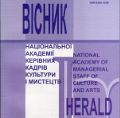ПОСТАВАНГАРД І НІМЕЦЬКЕ НЕОБАРОКО ХХІ СТОЛІТТЯ
POST-AVANT-GARDE AND GERMAN NEO-BAROQUE OF THE 21ST CENTURY
Author(s): Vasyl BabukhivskyiSubject(s): Cultural history, Music, Post-War period (1950 - 1989), Transformation Period (1990 - 2010), History of Art
Published by: Національна академія керівних кадрів культури і мистецтв
Keywords: baroque; neo-baroque of the 20th century; neoclassicism; post-avant-garde neo-baroque; German style in music; style of the era; post-avant-garde;
Summary/Abstract: The purpose of this work is to identify stylistic clarifications regarding such an all-encompassing and extremely influential direction from the last century as neo-baroque, which was perceived as an offshoot of the overall neoclassicism of the 20th century, taking into account the post-avant-garde contribution from the 1970s and the post-post-avant-garde ("neo-post-avant-garde") addition from 2010s – in the conditions of the German music world. The latter has held basic positions in art music since the times of the Viennese classicism, significantly supplying the repertoire of performance even today. The methodological basis of the study is the intonation approach, as it was noted in the works of B. Asafiev's followers in Ukraine (see the publications of D. Androsova, O. Markova, O. Muravska, and others), as well as based on the development of instrumental performance of the Odesa school (works by Z. Bupkatskyi, K. Muhlberg, other scholars). The scientific novelty of the work is noted due to the originality of the presentation of the meaning of the stylistic diffusions of instrumental art from the 20th to the 21st centuries, which made it possible to revive in the performance of works that bypassed artistry in favour of either church aestheticism of expression or frankly traditionalist thinking, which was not associated with ideas about the stylistic dynamism of German music of the last two centuries. Conclusions. The neo-baroque stylistic eclecticism of German art from the 20th century was based on the contributions of the stylistic extremism of P. Hindemith, which bypassed the "soft" detections in the works of A. Zemlinsky, Z. Wagner, F. Schmidt, and more, leading to the "neo-Schubertianism" of V. Rimm, which became the recognised leader of the German musical world at the break of the post-avant-garde and post-post-avant-garde heritages. Performance practice, performing the works of German post-avant-garde composers at the level of B. Zimmerman, J. Widman, A. Raiman, and other masters, organically combined it with the revival of the legacy of A. Zemlinsky, F. Schreker, Z. Wagner, F. Schmidt, as well as composers of the Baroque era – J. Molter, H. Telemann, and so on, whose thinking did not coincide with the criteria of the author's work of the New Age, but corresponded to the neo-baroque filling of the post-avant-garde with compositions marked by church aestheticism in bypassing the criterion of artistry, which we denote by the term "post-avant-garde neo-baroque" in music.
Journal: Вісник Національної академії керівних кадрів культури і мистецтв
- Issue Year: 2023
- Issue No: 3
- Page Range: 225-229
- Page Count: 5
- Language: Ukrainian

